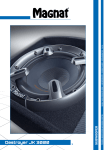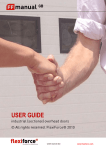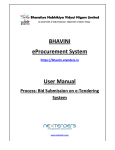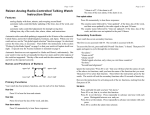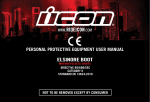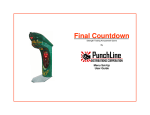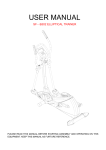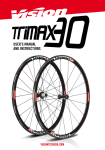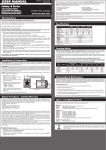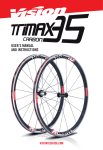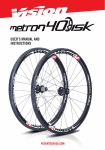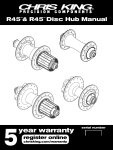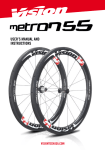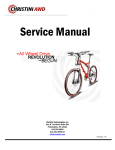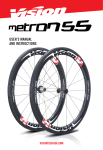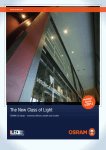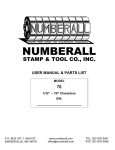Download hub service guide 1
Transcript
page 1 Hub Service Guide (Rear Mtn. Hub ) Section 1: Bearing Play Adjustment Industry Nine wheels are equipped with the highest quality ABEC5 bearings from the factory. Over time, all bearings will wear, developing some lateral play. Occasionally, during the break-in process, as bearings and other parts of the assembly seat more firmly, unsatisfactory lateral play may also develop. 1.1 Required Tools Adjustment will require a 1.5mm allen wrench, and may be performed with the wheel installed or removed from the bicycle. NOTE: Due to the preloading nature of 10 and 12 mm through-axle designs, it is recommended that these hubs be adjusted while installed on the bike. 1.2 Adjustment Find the 1.5mm allen head setscrew in the non-drive-side dustcap (fig. 1) . Loosen the setscrew 2 full turns to ensure the end of the screw clears the surface of the axle. The dustcap should turn freely once the setscrew is loosened. If not, use the allen wrench to gently apply enough leverage to turn the dustcap. If the dustcap seems stuck, attempt to loosen it first by applying counterclockwise force (looking from the disc side). Tighten the dustcap by hand until it stops against the disc-side bearing. Do not apply excessive torque, as this will cause premature bearing failure. Once freeplay is removed and dustcap is finger-tight, gently tighten the setscrew. This is a 3mm thread on a pointed setscrew, and as such requires very little torque (1.0 Nm / 8.8 in-lb). A good rule of thumb is 1/8 turn past the point at which the screw contacts the axle. If lateral play remains after performing this adjustment, please continue to bearing replacement, as the bearings have probably exceeded their service life. 1.5 mm set screw Fig. 1 Section 2: Freehub Drive Mechanism Service The recommended inspection and service interval for Industry Nine’s patented drive mechanism is annually. This is a recommendation only, and may have to be adjusted for severe climates, wet environments, frequency of riding, etc. It is recommended to service the drive mechanism during bearing replacement, as it must be disassembled to perform this maintenance. 2.1 Required Tools Tools required for service; 1.5 mm allen wrench, two (2) 5mm allen wrenches, a soft-faced (plastic or brass) hammer, and a soft-metal (such as brass or aluminum) drift punch or rod approximately 6" long x 1/2" diameter. A hard benchtop material such as formica or metal will also prove convenient. Removal of the pawls and springs will require a .050" allen wrench, which is usually the smallest in an English set. These .050" allen wrenches are also available from Industry Nine for the cost of postage. A scribe or very small jeweler’s screwdriver will be required for retaining clip removal. 2.2 Disassembly Remove the wheel from the bike and the cassette from the freehub body. It is not necessary to remove the disc rotor. Remove the disc-side adjusting dustcap from the axle by first loosening the 1.5mm allen setscrew in the dustcap 2 full turns. Remove the dustcap by unscrewing it counter-clockwise until it comes free of the axle. Place it to one side. page 2 Next, remove the drive-side steel endcap by placing a 5mm allen in each end of the axle and unscrewing the drive-side end. Also remove the axle spacer by sliding it off the drive end of the axle. Place these to one side. The freehub mechanism is pressed into the hubshell. To remove it, support the hubshell to the outside of the large back flange of the freehub. This can be done by padding a bench vise opened far enough to clear the freehub, or with two wood or plastic blocks supporting the hub above a bench. Alternatively, the hub may be supported by the hand not wielding the hammer (fig 2 & 3) . Remove the freehub mechanism by gently tapping the non-drive (disc side) end of the axle with a soft-faced hammer (fig 2 ). Take care to ensure the mechanism remains straight in its bore as it comes out or pawl spring damage may occur. Again: GENTLY tap the nondrive end of the axle until the large bearing comes free of the hub. The axle will slide all the way through the hub and come out the drive side with the freehub. Firmly grasp the large end of the axle and slide it out of the fr eehub bearings. (Fig. 4) depicts the freehub assembly and axle clear of the hub. 2.3 Pawl and Spring Removal The pawls must be removed in order to replace the large 61808 bearing. It is also recommended that they be removed annually for thorough cleaning and regreasing. If they appear to be well-greased and free of contamination, it is not necessary to remove them from the mechanism for simple inspection or addition of grease. Establish a clean, solid working area, as some parts are very small. One at a time, remove each spring retaining screw using a .050" allen wrench. Then remove the spring and pawl, taking care not to lose any of the tiny screws. Place these parts far out of the reach of swiping rags and mishandled tools. To change from 3 degree to 6 degree engagement, simply remove three alternating pawls and springs, leaving one set of three pawls in place in an equilateral triangle (fig 5) . Alternatively, to change from 6 degree to 3 degree engagement, replace the missing three pawls and springs following the instructions in section 3.2 “Pawl and Spring Installation” . Fig. 2 Fig. 3 Fig. 4 Fig. 5 2.4 Bearing Removal At this point, the two 61903/29.5 bearings inside the cassette body and the 61804 bearing in the disc side of the hub may be r emoved using a press or soft-metal drift punch. A rod or socket with a diameter of 18mm will allow easy removal of both cassette body bearings from the back. Ensure the cassette body is well-padded when supported in a press or bench vise to prevent damage. NOTE: Removal of bearings using a drift punch will usually damage them, r endering them useless. The spacer between the 61903/29.5 bearings should slide out easily by hand once the outer bearing is r emoved. If the large 61808 bearing exhibits play or roughness, it should also be replaced. In order to remove this bearing from the freehub body, the six pawls and their respective springs must first be removed. Please refer to Section 2.32 “Pawl and Spring Removal” prior to attempting to remove the 40x52mm 61808 bearing. To remove the 61808 bearing, first remove its retaining clip by GENTLY and CAREFULLY prying one end free of its groove using the point of a scribe, jeweler’s screwdriver, or knife. USE CARE to not stab yourself. Once one end of the clip is lifted free, gently work it out of the groove all the way around to the other end, taking care not to twist or otherwise mangle the retaining clip. Once free of its groove, remove the clip and place it to one side. page 3 Remove the bearing by repeatedly firmly tapping the back of the freehub against a hard surface (non-marring), such as a wooden or formica benchtop (fig 6) . Inertia will cause the bearing to slide free of the freehub body. DO NOT use a metal or concrete surface to accomplish this as it will damage the aluminum freehub. Often, the bearing can be removed using one’s fingernails behind the outer race. Take care not to peel your nails back attempting this. Section 3: Hub Reassembly Bearings are best installed in hubshell and cassette body using an arbor press. If a press is not available care must be taken using other methods to ensure the bearings are pressed in their respective bores completely straight. When pressing bearings into bores find a socket or other cylindrical object to apply pressure to only the outer race of the bearing, as pressing the inner races or dust seals will damage the bearings. Likewise, when pressing bearings onto the outside of bearing journals, apply pressure only to the inner race. If using a bench vise, soft metal or flat (non-toothed) jaws are recommended. Ensure all bearing mating surfaces are clean and free of grit or dirt prior to installation. A very light coat of grease is always recommended. Bearing retainer clip Fig. 6 Fig. 7 Fig. 8 3.1 Bearing Installation To install the 61903/29.5 bearings in the cassette body, slip the first bearing in past the threads, until it begins to press. Then use the 7075 bearing spacer atop the bearing to press it in until the end of the spacer is flush with the end of the cassette body (fig 7) . Place the second bearing on the end of the spacer and press it in until it is also flush. Using the appropriately sized socket (or an old bearing), continue to press the outer bearing until both bearings and spacer are firmly seated in the bearing bore. The large 40mm x 52mm 61808 bearing is installed on the back of the fr eehub body by first starting the bearing past the retaining ring groove. The bearing journal is slightly undersized for the first millimeter to aid in starting the bearing straight. The bearing can often be completely installed with firm hand pressure. If a press is necessary, find a cylindrical piece of material (a short piece of 2” PVC pipe works well) that fits on the inner race of the bearing and gently press it on the freehub until the retaining ring will fit in its groove (fig 8) . Install the retaining clip, ensuring it is completely seated in its groove by firmly pushing it down into the groove starting at one end of the clip and working completely around to the other end (fig 9) . To install the 61804 bearing in the non-drive end of the hub, start the bearing into the end of its bore by hand. Find an appropriately sized socket or use the old bearing to carefully press the bearing until it is firmly seated in its bore (fig 10) . Work carefully to ensure the bearing remains completely straight during the entire process. Pad the drive end of the hubshell with a non-marring material such as plastic or wood to ensure the freehub bearing bore is not deformed. Once the bearings are installed, the pawls and springs may be reinstalled on the freehub body. Fig. 9 Fig. 1 0 Fig. 1 1 3.2 Pawl and Spring Installation If the pawls and freehub body have been degreased, apply a small dab of grease to each pawl pocket to assist in keeping the pawls in place during spring installation (fig 11) . If available, it is also recommended to apply a tiny drop of medium-strength Loctite to each of the similarly-sized pawl spring retaining screws. page 4 One at a time, reinstall the springs. Place the spring in its recess on the freehub body. Note that the spring is shaped such that it can only be properly installed in one orientation. Ensure that the radiused corner of the spring is oriented toward the large 61808 bearing (fig 12) . Install the screw carefully, ensuring it does not cross-thread. As the screw is tightened, gently apply pressure on the pawl and spring towards the back of the pawl pocket to ensure the pawl remains fully engaged in the pocket and the spring is not twisted away from the large bearing (fig 13) . These screws are size 0-80 using a .050” (~1.2mm) allen wrench, and as such, require a tiny amount of torque (<3 in-lb). Tighten no more than 1/10 of a turn past snug. Repeat the process until the desired number of pawls are in place; 3 pawls for 6 degrees or 6 pawls for 3 degrees before engagement. Once the pawls and springs are installed, the freehub assembly may be reinstalled in the hub. Insert radiused edge of spring into the radiused pocket of cassette body. Fig. 1 3 Fig. 12 3.3 Drive Mechanism Installation If old grease has been cleaned or the mechanism has been degreased, apply a liberal amount of light grease to the drive ring cavity and pawl mechanism (fig 14) . Drive mechanisms are factory assembled with DuMonde Tech Freehub Grease. 1 oz. containers are available directly from us or DuMonde Tech. If unavailable Slick Honey, Rock ‘n’ Roll Super Slick, or Dumonde Tech liquid grease will work. To ease reassembly of the drive mechanism, there are six slots milled into the circumference of the drive ring (fig 15) . These accept the pawls and simplify the reengagement of the pawls in the drive ring. Begin reassembly by visually lining up the pawls with these slots. Once lined up, gently push the pawl mechanism into the bore by hand approximately 1 millimeter until it the pawls stop against the drive ring. The large bearing bore is slightly oversized at the outer end to ease straight installation. Continue the process by rotating the freehub backwards (freewheeling) to engage the pawls in the drive ring. Feel and listen carefully for smooth, consistent pawl ratcheting. Once the pawls are engaged, push the freehub body into the hubshell by hand approximately another millimeter until the bearing begins to press fit. Once again verify the smooth operation of the pawl mechanism. Complete the process by pressing the assembly into the hub until it is fully seated. Use the utmost caution to ensure the assembly remains absolutely parallel to its center axis or pawl spring damage will occur. When the freehub is fully seated, the largest diameter of the freehub flange will be flush with the edge of the hubshell (fig 16) . Once the drive mechanism has been reassembled, the rear axle may be reinstalled. Drive ring slot (1 of 6) Fig. 1 4 Fig. 15 Fig. 16 3.4 Axle Installation Begin by replacing the adjusting dustcap on the axle. Thread it on clockwise until the outer edge of the dustcap ish flush with the end of the axle. Slide the axle into the hub from the disc end until the adjusting cap stops against the bearing. Slide the axle spacer on the drive end of the axle and reinstall the stainless steel endcap. Tighten gently to 4 Nm/35 in-lb using a 5mm allen wrench in each end of the axle. Push the axle back to the disc side by hand or by gently tapping the drive end on a workbench. Hand tighten the adjusting dustcap against the disc-side bearing. Adjust bearing freeplay by following the instructions in “Section 1: Bearing Play Adjustment.”




